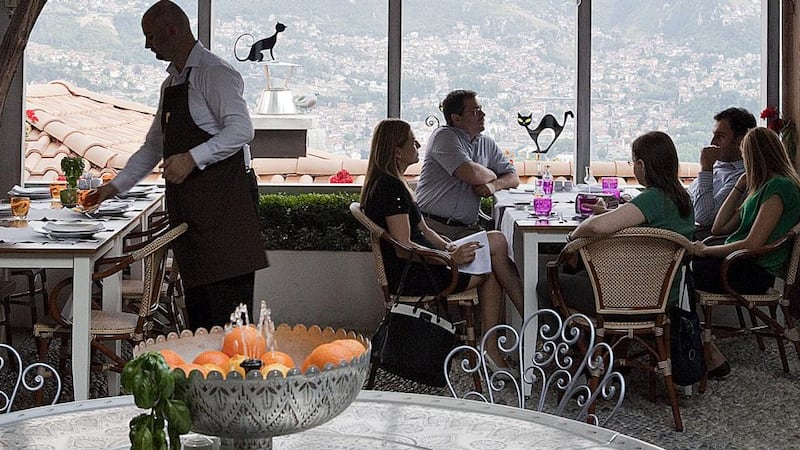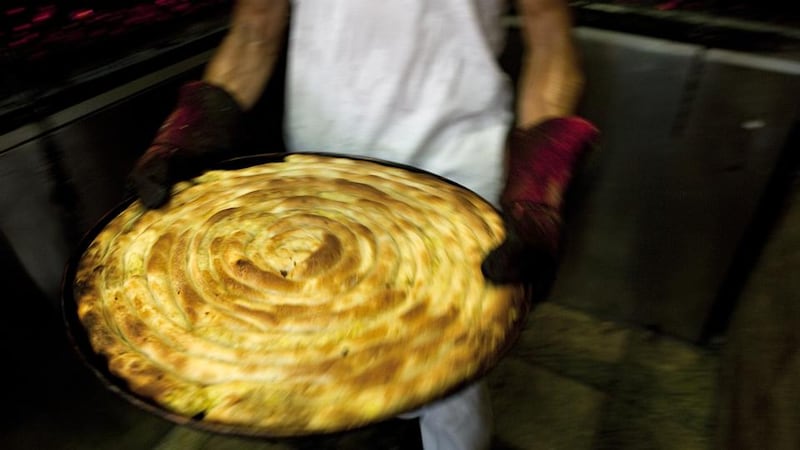At midday in Sarajevo, muezzins call from minarets as church bells echo through the Dinaric Alps. Street cars rumble past hookah smokers and cafe-goers. Chic women click-clack down cobbled alleyways. The city’s charisma is intoxicating, but the hustle and bustle belies a tragic past. In 1992, Bosnia-Herzegovina’s capital changed from a beacon of diversity, with Yugoslav Muslims, Christians and Jews worshipping within feet of one another, to the site of a nearly four-year siege that claimied more than 11,000 lives.
But much has changed over the past decade or so. The creative spirit that Sarajevans fought to preserve is very much in evidence these days. Neighbourhoods cradled in this valley and ringing the foothills are fertile entrepreneurial grounds and a testament to the epochs that came before.
Cafes, theatres, boutiques and restaurants have sprouted up among buildings in myriad styles, including Ottoman, Secessionist, communist and modern. And locals and visitors alike are rediscovering the surrounding mountains on the slopes that hosted the 1984 Winter Olympic Games.


Friday
6pm
Secessionist seduction
Sarajevo's circuitous history lesson begins with dinner at 4 Sobe Gospode Safije (the Four Rooms of Mrs Safija). It occupies a house built in 1910, the epoch of the city's 40-year Habsburg Empire, by an Austrian count for a local woman, Safija. Their crosscultural love was taboo, but this Bosnian-European restaurant, restored to early 20th- century splendour and filled with period pieces, is among the city's best. Choose the grilled veal with rosemary and anchovy (28 Bosnian convertible marks, BAM/€14.31) or the sea bass with ginger (21 BAM/€10.73) and a bottle of local red Blatina (35 BAM/ €17.89) or white Zilavka (35BAM/€17.89).
8 pm
Theater of the soul
In the same neighbourhood, below the former Olympic stadium, get in before the lights dim at Sarajevski Ratni Teatar (the Sarajevo War Theatre, or Sartr). Established a month after the siege began, Sartr put on hundreds of shows during the war and became a symbol of defiance. "Being creative was the only way to survive during the war," says Nihad Kresevljakovic, the theatre's director. "In that way, Sarajevans know that culture and art are really basic human needs, like food and water."
The black-box repertory (tickets from 5BAM/€2.55) still channels those exposed-nerve instincts into empathetic works – musicals, dance, documentary theatre and dramas – on the city's most creatively free stage. Coming productions include The Secret of Raspberry Jam, which provides an intimate look at Sarajevo.
10 pm
Fish kitsch
For a nightcap, head to Zlatna Ribica (Golden Fish). Diagonally across from the Eternal Flame honouring victims of the second World War, this cafe and bar is Sarajevo's kitschiest drinking hole. A wall of mirrors reflects a softly lit tangle of refitted candelabras, decanters, overstuffed armchairs, musical instruments, Christmas lights, tiny TVs flickering black-and-white images and a bowl with goldfish swimming at the junction where the bar's two rooms meet. In the background, jazz plays. In winter, try the secret-recipe mulled wine (5BAM/€2.55); in summer, order sangria with oranges and cherries.
Saturday
9.30am
Coffee talk
For Sarajevans, drinking coffee is a ritual for relaxing, not quickening the pulse. Inside the rustic Cajdzinica Dzirlo, on Bascarsija's eastern edge, you can unwind and imbibe thick, frothy, slow-brewed Bosnian coffee served in copper pots (3BAM/€1.53 for a two-cup serving). For a more modern take on this intrinsic custom, visit Rahatlook, on Bascarsija's west end, and enjoy your kafa (coffee) with pastries like the walnut-strewn orasnica (3BAM/€1.53).
11 am
Tunnel of love
The Times of Misfortune tour (54BAM/ €27.60) helps decode the complex layers that make up Sarajevo, where a new national flag has been hoisted seven times in the past 150 years. Sarajevo Insider guides do a masterly job explaining the tempestuous transitions, focusing on the war from 1992 to 1995. You'll take in panoramas of the valley from the ancient White Fortress before returning to town to the site of Archduke Franz Ferdinand's assassination, in 1914, and the cemetery-surrounded Olympic stadium. The highlight is the Tunnel Museum, where, in 1993, citizens dug a 792m subterranean passageway that became the besieged city's sole supply line to the outside world.
1 pm
Dining in the hood
Take a taxi (5BAM/€2.55) into the foothills through Sarajevo's oldest, Ottoman-era mahalas (neighbourhoods) for lunch at Restaurant Kibe. When you get to the house, ring the doorbell (reservations are a must) and climb the stairs to a diningroom anchored by a fireplace and surrounded by panoramic views of town. Kib serves some of the city's best traditional dishes. For a starter, try sour-cream-smothered klepe (12 BAM/€6.13): meat-filled Bosnian ravioli. To guarantee the spit-roasted lamb (14BAM/€7.15), a specialty, place your order when you make a reservation. Before pushing away from the table, loosen your belt buckle for the fresh pita od jabuka, or apple pie (5BAM/€2.55).
3 pm
Vintage foraging
Along Sarajevo's main shopping promenade, which changes name from Saraci in the Ottoman quarter to Ferhadija in the Secessionist-era zone, artisans sculpt, stitch and solder in hidden-alley shops. Down one alley, visit Kazandzijska Radnja at Kazandziluk 18, where Muhamed Husejnovic hammer-shapes copper coffee sets. Next to the 16th-century Gazi Husref-bey Mosque, Becart specialises in site-crafted silver jewellery. On Ferhadija, at Edo, the shoemaker Edo Smajic takes your footprint and creates one-of-a-kind leather shoes and boots, keeping your file for future orders.
5 pm
Contemporary compassion
Sarajevo's creative DNA can be seen in repurposed gallery spaces across town. The Ars Aevi Museum of Contemporary Art houses the city's most exciting collection (entrance is free and by appointment). The idea, born in 1992, was to invite artists to become founders in a new museum rooted in camaraderie; since then, some of the world's most accomplished maestros have donated nearly 200 pieces. Today, contemporary works by heavyweights such as Jannis Kounellis, Joseph Kosuth and Robert Kushner fill a temporary art depot until funds for a new building, designed by Renzo Piano, can be raised.
7.30 pm
Eat your veggies
In a town deficient in vegetarian options, Karuzo Restaurant is a blessing. It's behind the green market, where the owner, chef and waiter Sasa Obucina buys ingredients. Inside, shaped like the interior of an upside-down boat, there's room for 20 diners. Rubbing elbows and extolling the seasonal menu with neighbours is part of the charm. A baked pumpkin gratin with chickpeas and goat's cheese (17BAM/€8.69) is rich, lasagna-like and perfect with a glass of white wine from the international list. For nonvegetarians, there is seafood and even sushi (15BAM/€7.66 for an eight-piece tuna roll).
10 pm
Rakija rampage
Generations of Bosnians have grown up drinking family-made moonshine called rakija. In recent years, this fruit- or herb-flavoured, grappa-like elixir has become the hipster spirit of choice. At the multilevel Barhana Restaurant and Grapperia, you'll find 25 varieties, a stone oven for late-night pizzas and a hidden summer garden in the heart of Bascarsija. As in any good rakija joint, the choices, including plum, cherry and honey, are etched on a chalkboard. Try the travarica, a herbal tincture good for digestion and mood.
Sunday
10.30 am
Bosnian brunch
No one is ambivalent about Sarajevo's rich street food. Cevapcici (che-VAHP-chee- chee) – beef sausages served with flatbread, onions and a creamy cheese called kajmak – reigns supreme. At Cevabdzinica Zeljo 1, prepare to order in increments of five (3.5BAM/€1.78). Coming in a close second is burek: pastry dough filled with beef. Potato, cheese and spinach versions are called pita. At Buregdzinica Bosna, pair these savory pie portions (about 3BAM/ €1.53) with a glass of yogurt. Complete your tour at Cafe Slasticarna Ramis, a 100-year-old sweet shop with traditional tufahija (4BAM/€2.04), poached apple filled with whipped cream and walnuts.
Noon
Above it all
Tucked into a river-cut valley surrounded by peaks, Sarajevo has a natural beauty often forgotten amid artificial contrivances. Green Visions has run ecotours for more than a decade and will pick you up anywhere in town.
Tighten your boot laces and take a three- to four-hour hike (80BAM/ €40.90 a person) through spruce forests before reaching the summit of Trebevic, a 1.6km mountain. You'll have commanding views of the range that hosted skiing events in 1984. You'll also have a better grasp of one of the world's most riveting cities.
– New York Times Syndication







